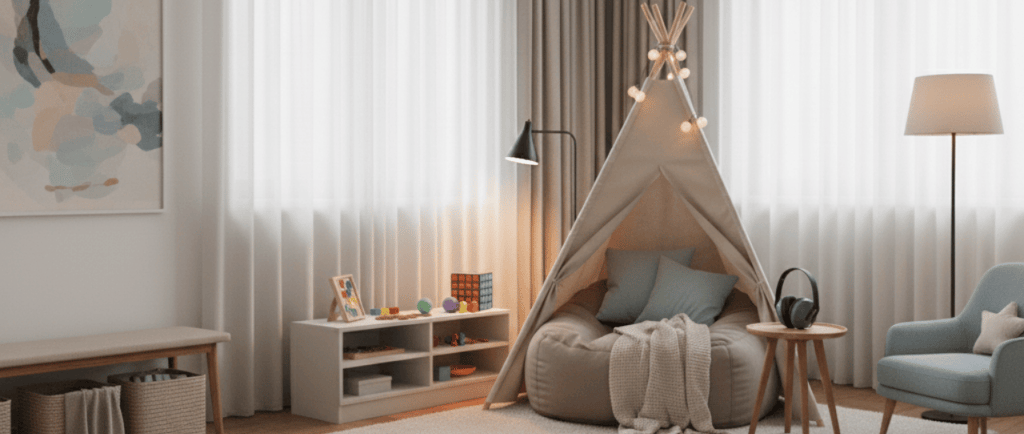Creating a Sensory-Friendly Home Environment for Your Child
How to create a Sensory-Friendly Home Environment for Your Child?
OCCUPATIONAL THERAPYSENSORY INTEGRATION
Dr. Dipak Kumar
10/4/20254 min read


For many children—especially those with Autism Spectrum Disorder (ASD), ADHD, or sensory processing difficulties—the home environment can make a huge difference in how calm, focused, and happy they feel each day. Children who are sensory-sensitive experience the world more intensely; bright lights, loud noises, or even certain textures can feel overwhelming. Creating a sensory-friendly home isn’t about turning your space into a therapy clinic—it’s about small, thoughtful adjustments that help your child feel safe, comfortable, and in control.
Let’s explore how you can set up a calm, sensory-friendly home step by step.
1. Understand Your Child’s Sensory Needs
Before making changes, spend a few days observing your child. Notice what environments make them feel calm versus stressed. Some children are sensory seekers—they love movement, jumping, and crashing into things—while others are sensory avoiders, preferring quiet and gentle surroundings.
Ask yourself:
Does my child cover their ears at loud sounds?
Do they crave tight hugs or soft blankets?
Are they sensitive to certain fabrics, smells, or lights?
Once you identify patterns, you can design your home to match their sensory profile rather than fighting against it.
(Tip: Occupational therapists often use tools like the Sensory Profile 2 to assess these needs. If possible, consult your child’s therapist for personalized guidance.)
2. Create a Calm “Cool-Down” Corner
Every child—especially one with sensory sensitivities—benefits from a safe retreat when the world feels “too much.”
This doesn’t have to be a big room; even a cozy corner works.
How to set it up:
Choose a quiet corner away from busy household areas.
Use soft lighting—avoid harsh overhead bulbs; instead, use a small lamp or string lights.
Add comfort items: bean bag chair, soft pillows, or a tent-style canopy.
Include calming sensory tools: noise-cancelling headphones, weighted blanket, or squishy fidget toys.
Post simple visuals like “How I Can Calm My Body” charts or emotion cards.
Encourage your child to go there voluntarily when they feel upset—not as a punishment, but as a place to “reset.”
This teaches self-regulation and independence in managing emotions.
3. Manage Lighting and Visual Stimulation
Lighting can dramatically affect a child’s mood and focus. Many children with sensory sensitivities are bothered by fluorescent lights or bright sunlight.
Try this:
Use natural light as much as possible—open curtains in the morning.
Install dimmable lights or lamps with warm bulbs.
Avoid busy wallpaper or flashing lights.
Keep colors soft and neutral in areas meant for rest.
Use blackout curtains in bedrooms to support better sleep.
If your child seeks visual stimulation, offer visual toys or light-up sensory items in play areas—but limit them in sleep or homework zones.
4. Reduce Noise and Auditory Distractions
Unexpected or loud noises can be distressing for some children.
To help:
Use soft furnishings (curtains, carpets, cushions) to absorb sound.
Offer noise-cancelling headphones or ear defenders for loud environments.
Play gentle background music or white noise to block sudden sounds.
Keep the TV or music volume moderate—and avoid multiple sound sources at once.
If your child is sensitive to sudden household noises (like the blender or vacuum), give them a heads-up before turning them on. Predictability helps reduce anxiety.
5. Organize and Declutter Spaces
Visual clutter can overwhelm a child’s sensory system. A tidy, structured space helps the brain feel calm and focused.
Limit unnecessary decorations—too many toys or bright posters can distract.
Use clear bins with picture labels (e.g., “Blocks,” “Puzzles”) so the child can find and put away toys easily.
Keep only a few toys out at a time; rotate them weekly for novelty.
Maintain zones—for example:
Quiet zone (reading corner)
Active zone (play area)
Work zone (homework desk)
Children feel more secure when they know where things belong and what each space is for.
6. Maintain Predictable Routines
A sensory-friendly home isn’t only about the physical environment—it’s also about emotional structure. Predictability helps children feel safe and reduces meltdowns.
Try to keep:
Regular wake-up and bedtime routines
Consistent meal and snack times
Visual schedules (using pictures for younger kids) showing what’s next
Transition cues—for example, a timer, song, or phrase like “In five minutes, we’ll clean up and have lunch.”
This predictability supports self-regulation and makes the day feel less chaotic.
7. Include Sensory Tools and Activities
Having the right sensory tools available gives children safe ways to seek or avoid input depending on their needs.
Ideas for sensory tools:
Fidget toys (spinners, stress balls, putty)
Weighted lap pad or blanket
Balance cushion or wobble stool
Swing or small trampoline (if space allows)
Sensory bin with rice, beans, or sand
For children who crave movement, consider “heavy work” activities like carrying groceries, pushing laundry baskets, or wall push-ups.
These activities provide proprioceptive input (deep body pressure) that helps the nervous system feel grounded and calm.
(Research by Ayres (1972) and subsequent studies highlight that structured sensory input helps regulate arousal and improve focus in children with sensory processing challenges.)
8. Prioritize Sleep and Rest Spaces
Sleep struggles are common among sensory-sensitive children. To make bedtime smoother:
Keep the bedroom cool, dark, and quiet.
Use weighted or soft blankets.
Avoid screens an hour before bed.
Try a consistent bedtime routine (bath, story, dim lights).
Use white noise machines if your child wakes up easily due to sound.
A well-rested child is better able to manage sensory challenges during the day.
9. Support Self-Regulation Skills
Empower your child to recognize their body’s signals:
Teach them to notice when they feel “too loud,” “too fast,” or “too tired.”
Use phrases like “Let’s take a break and calm our bodies.”
Model deep breathing, stretching, or mindfulness.
Over time, your child learns that they can choose strategies (e.g., using their cool-down corner or squeezing a stress ball) to feel better.
This builds independence and emotional resilience—a long-term goal of occupational therapy.
10. Extend These Strategies to School and Public Places
Children benefit most when home and school environments work together.
You can:
Share your child’s sensory needs with teachers and therapists.
Suggest classroom adaptations: flexible seating, quiet zones, fidget options, or noise-cancelling headphones.
Encourage short sensory breaks during the school day (like wall push-ups or breathing exercises).
According to the American Occupational Therapy Association (AOTA, 2020), collaboration between parents, educators, and therapists helps create consistent, supportive environments that reduce overwhelm and improve learning outcomes.
A sensory-friendly home doesn’t require expensive equipment—it’s about understanding your child’s world and adjusting the environment to support them. Small changes like dimming the lights, offering a quiet corner, or sticking to a daily routine can transform your child’s comfort, attention, and confidence.
Every child’s sensory profile is unique, so observe, experiment, and celebrate what works for your family.
Over time, your home will become a space where your child can thrive—not just survive.
Tags:
Sensory Integration, Occupational Therapy, Parenting Tips, Sensory Processing Disorder, Autism Support, ADHD, Child Development, WeeCare
Connect
Reach out for personalized child support
CONTACT US
Join our community
info@weecare.in
+91-8877 3535 14
WeeCare© 2025. All rights reserved.


Important links
We Accept


